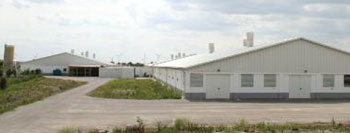



East European Potential Fuelling Future Growth
GERMANY - The potential for growing the chicken market in new nation states across central and eastern Europe provides an exciting challenge for Cobb Germany as the company celebrates 10 years since the first Cobb 500 parents were hatched in its newly built hatchery at Leipzig.From the initial concept of supplying 2.5 million Cobb parents a year for the German industry is a plan now to reach 10 million a year for the 21 countries within the company's franchise.
This year the hatchery will be producing more than 7 million parents, and with ongoing expansion and the commissioning of new grandparent farms the increase to 8.5 million in 2009 is already under way.
Cobb Germany is part of the Wimex organisation - an anagram devised in 1985 based on the idea of importing and exporting broiler hatching eggs and on the purchase of four parent stock farms for 260,000 birds.
The reunification of Germany in 1989 presented huge opportunities for entrepreneurs. Through the 1990s Wimex was able to acquire former state farms in East Germany, converting many of the livestock buildings for poultry and going into large-scale arable farming and vegetable production.

Since the opening of the Cobb Germany hatchery at Wiesenena, on the outskirts of Leipzig airport, significant developments have included a new 40,000 tonne-capacity feed mill to supply grandparent farms, acquisition of the Mecklenburger complex of parent and broiler farms, and this year a new €11 million biogas enterprise using poultry manure to generate energy.
Now Wimex has a turnover of €160 million a year. The core business has 67 parent stock farms, producing 280 million hatching eggs a year, hatching 50 million broilers chicks a year and rearing 8 million broilers a year.
Cobb Germany has some 320,000 Cobb 500 grandparents on 29 farms, varying from 9000 to 24,000 female capacity and with an average of 1.8 units of labour per farm.

Gerhard Wagner, who has led the phenomenal growth as the owner of Wimex, explains why Cobb Germany has continued to expand. "I think it's mainly through our staff who have done a very good job and also the success that our customers have had with the Cobb bird. Our people have built close relationships with our customers and this has been part of the success, too," he said.
In the near future he sees the greatest potential for growth in Ukraine, Poland and Romania, but is also optimistic about the domestic market in Germany with the trend from frozen to fresh chicken increasing demand.
The enormous agricultural potential in central and eastern Europe is the focus for Cobb Germany managing director Graf von Drechsel and his fellow director James Truscott who joined the business in 2005 after 14 years in sales and technical roles with Cobb Europe.
* A festival to celebrate the 10th anniversary at the Wimex headquarters at Baasdorf in July was attended by more than 40 Cobb Germany colleagues, sales and technical managers and veterinarians from 20 countries. |
"Take the example of Ukraine," says James Truscott. "The country has many advantages for producing poultry meat. There are abundant raw materials: it's now producing around 25 million tonnes of grain and has the potential to treble that. Energy and labour costs are lower than in the West, and there is large investment in some very modern farms. Ukraine could become a substantial exporter of poultry meat to western Europe."
Poland is a very different market, with a multitude of small flock farmers and broiler growers and independent hatcheries and processors. "This presents a very different type of challenge in being able to supply and service lots of small operators," he says. "But we are making significant progress and Cobb has more than 50 per cent of the market."
To supply these growing markets Cobb Germany is investing in ongoing hatchery and farm expansion. The new farms, like those on the former Köthen airfield, have been designed to state-of-the-art standards on landscaped sites. A far cry from the first breeder farms at Radefeld, converted from former state-owned egg laying units built more than 30 years ago.








